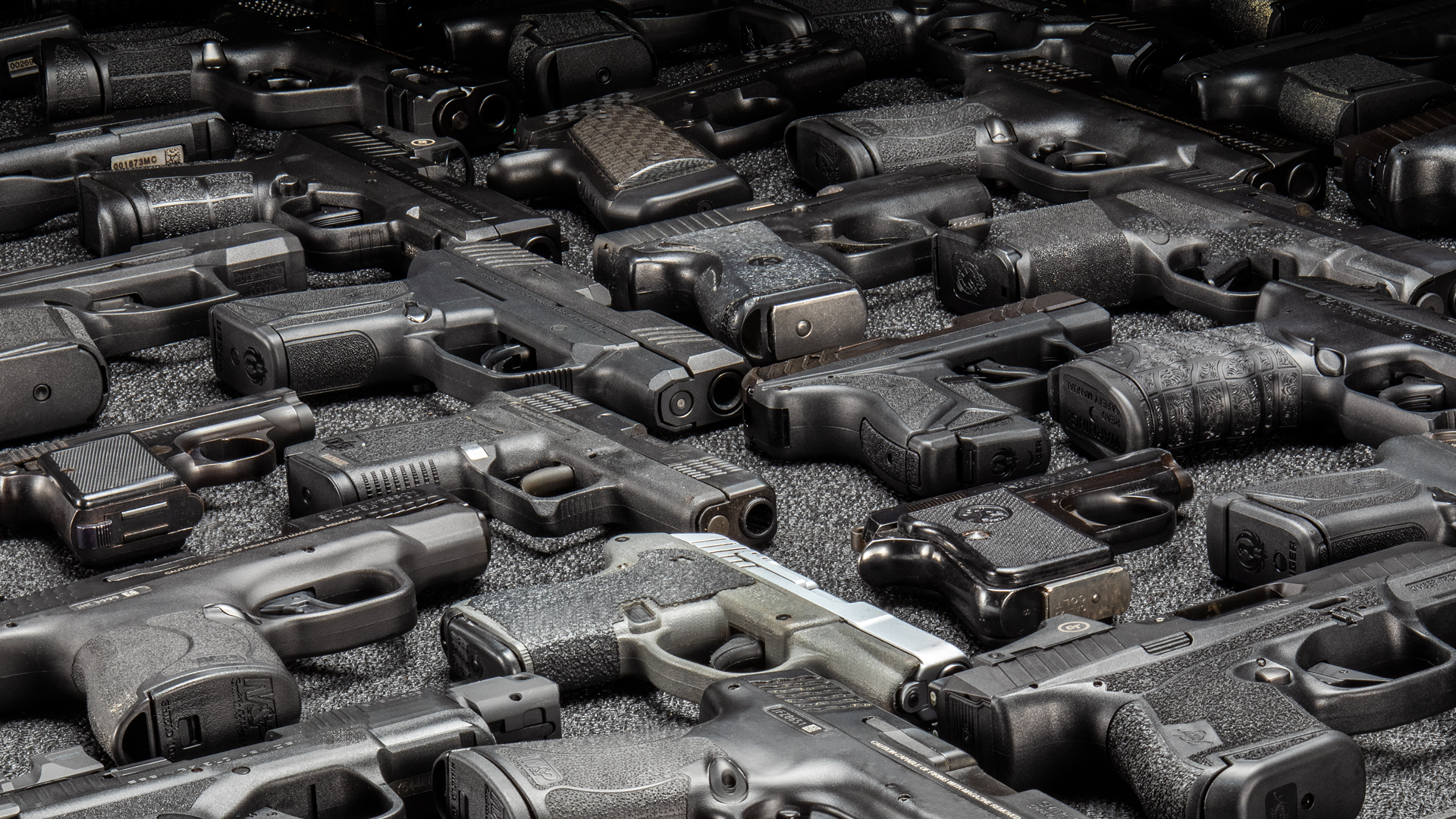
Posted on 12/30/2021 6:01:34 AM PST by COBOL2Java

Many of their first choices were full-size or compact models. In fact, compact models were the most requested due to the ability to perform double duty for both home defense and concealed carry. These compact models generally are the most popular variants I’ve seen in my shooting/marksmanship and concealed-carry classes.
Some folks were lucky and were able to purchase their preferred choice. Others discovered they had to broaden their searches to the subcompact market. It turns out, subcompacts have a solid footing in the concealed-carry market for a lot of reasons. Here are the three most common factors helping make the subcompact pistol so popular: They are easy to conceal, they now can deliver better terminal performance and their reliability has significantly improved.
First, we have to define a subcompact pistol, and determine what are their characteristics. The first characteristic would be the size, obviously. When you think subcompact, you think a small, lightweight package. Size can be described by two traits, barrel length and magazine capacity. Most of the subcompacts traditionally have smaller magazine capacities. There was a time when six rounds were all you could get in a 9 mm platform. Now, we see a similar-size frame holding a 10-round magazine, and sometimes more. Like anything though, there are points of diminishing returns. At a certain point, increased magazine capacity will mean the subcompact is no longer a subcompact, and may not even be easily concealed anymore.
Doubtless, these new magazine designs have something to do with the popularity. Many early models were single-stack design, however today’s modern subcompact pistol often comes in a modified, staggered-column design. While not the same double-column design as larger-frame handguns, it’s still not a single stack.
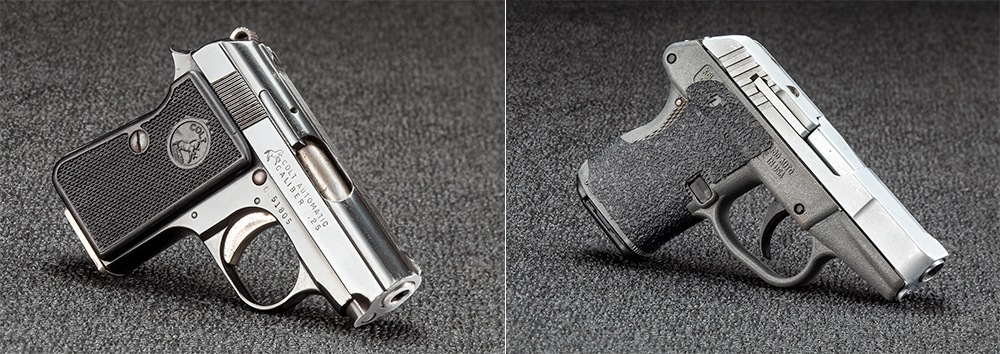
(l.) Tiny pistols chambered in anemic cartridges like .25 ACP made up the bulk of “pocket” guns for many decades. (r.) Kel-Tec’s P3AT offers 6+1 rounds of .380 ACP in a pistol that can be concealed nearly anywhere.
The barrel for most subcompacts is generally going to be about 3 inches long. The shorter barrel length aids in concealing the firearm. Short barrels make it easier to fit into more unconventional carry modes such as ankle carry, pocket carry and various under-the-shirt-type options.
The shorter barrel also equals a shorter sight radius, though. Traditionally, many subcompacts came with poor sights that were often replaced with aftermarket models to improve their visibility and accuracy. The challenge goes beyond the shorter sight radius, meaning there is a greater divergence with incorrect sight alignment. Smaller errors on the larger frames will produce less of a shot error. Shorter-barreled handguns don’t share this luxury.
Probably the biggest problem with the shorter barrels, however, was the poor performance of defensive ammunition out of them. The reason for this poor performance typically had to do with two issues: under-penetration and poor expansion as a result of lower velocities generated from the shorter barrels. Luckily, as these subcompact firearms became more popular, ammunition manufacturers began to address this issue by designing special ammunition for barrels 3 inches and shorter. The higher-pressure defensive ammunition typically seen in +P-rated types can be more abusive on the subcompact frames. A significant issue is the shorter slide cycles faster and the magazine spring can have a difficult time keeping up with the increased slide velocity, causing various types of stoppages. Modern ammunition designed for subcompact pistols with short barrels addressed these two concerns and has virtually eliminated these problems.
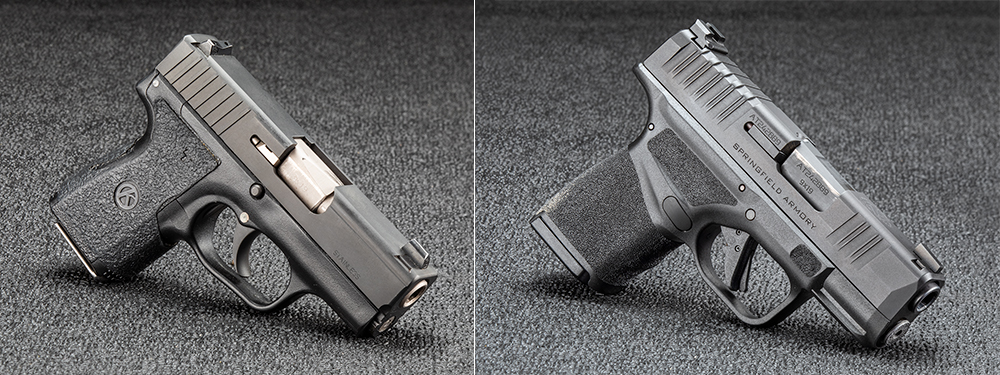
(l.) Early single-stack subcompacts like Kahr’s PM9 brought full-power ammo to the small pistol, but with the same capacity as tiny .380s. (r.) Modern firearms like the Springfield Armory Hellcat offer plentiful capacity in 9 mm, and in most cases even allow red-dot optics.
A couple of honorable mentions for the increased popularity of subcompact handguns would be caliber and supporting equipment. Early subcompact pistols came in some pretty small calibers, such as .22 LR, .25 ACP and.32 ACP. While convenient in size, terminal performance has long been a glaring drawback with these rounds. Not only are the relatively anemic compared with more robust options, they can be hard to find in defensive loads. If you were lucky enough to find premium, hollowpoint defensive ammunition in such a caliber, it typically had poor terminal performance. In some cases, you were better off using full-metal-jacket ammunition to ensure better reliability, which, for some of these smaller calibers, also was suspect. While the smallest caliber I normally saw in my classes was .380 ACP, it used to be notorious for experiencing many stoppages. Lately, both modern subcompact handguns and the ammo designed for them—particularly .380 ACP and 9 mm—are better designed, more reliable and more effective than they were when the platforms and ammunition were frowned upon.
As the popularity of the subcompact pistol grows, so too does the demand for supporting equipment such as additional magazines, holsters and aftermarket parts. One of the biggest issues faced in the past was the poor choice of holsters for these tiny handguns. Without good holsters, safety was a concern and training was therefore challenging. With few magazines—a major problem considering the low capacity of a subcompact—the student was often left further behind. The few subcompacts I owned were popular for that time, but finding a suitable holster I could carry regularly made them relics. Today, new subcompact owners get to enjoy a wide array of quality supporting equipment at their fingertips.
Early in the subcompact era, these firearm platforms were designed with less robustness. Shooting one of these small blasters in a high-round-count training class was almost unheard of, and certainly challenging. In my experience, I only saw the occasional model in my classes. Many times, we would have students approach me regarding the firearm they typically carried concealed. It wasn’t the handgun they planned on using in the class. It was smaller, with a smaller magazine capacity and poor sights, along with a heavy trigger. As a result, the student would rather shoot a larger handgun than the one they intended to carry because that would be significantly easier for them. Clearly, this was a less-than-stellar idea, but I don’t blame them. Those who opted to shoot their preferred carry handgun tended to experience a variety of issues, primarily in reliability—of both the pistol and the shooter. Built for concealment, these older models didn’t have the durability to sustain high-round counts without experiencing problems, and the shooters would invariably grow weary of shooting a lot of rounds through such uncomfortable guns that had to be constantly reloaded (and magazines replenished). It was challenging and disappointing for everyone, myself included.
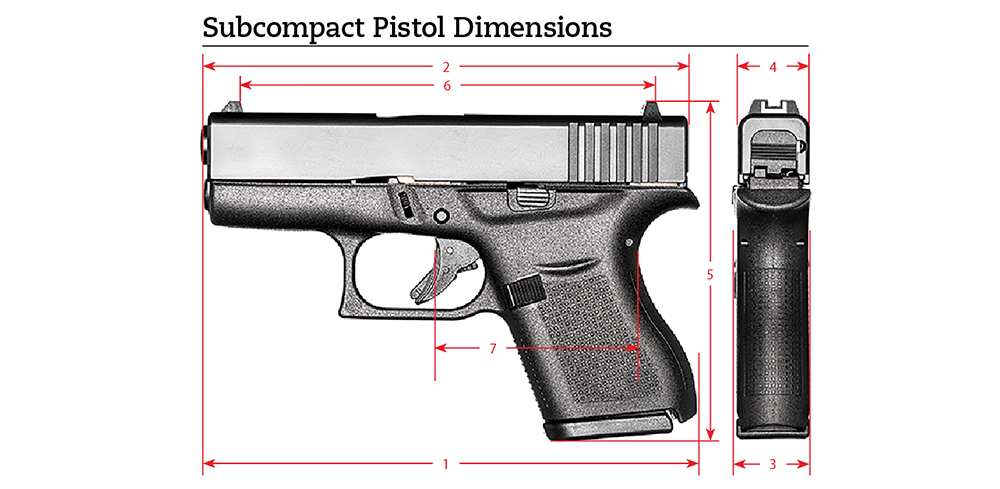
As a general rule, subcompact pistols tend to have overall lengths (1) less than 6 inches, barrel lengths around 3 inches and a height (5) around 4.5 inches. Overall width (3), thinnest width (4), sight radius (6) and slide length (2) also play into how concealable a pistol is, while distances like trigger reach (7) are more a factor of how it fits the hand.
The trend started changing about a decade ago, when significantly improved subcompact firearms first started entering the market. Not only did I begin to see more in my classes, but students also started performing better with them. These modern-day subcompacts separated themselves from their predecessors with better sights, better triggers and increased magazine capacities without sacrificing concealability. The biggest advancement was in their reliability. Now, built for hard work, these subcompacts can easily keep up with their larger siblings.
Many first-time gun owners were skeptical about their purchase if it wasn’t their top pick. Those who came through training classes come to appreciate the benefits of a modern subcompact. They can be more challenging to shoot, with a smaller grip surface and more pronounced recoil, but these concerns are easily managed with proper technique and practice. These smaller-size handguns have helped consumers learn to carry concealed more easily. As someone new to carrying concealed, a smaller pistol can help with the learning curve. Terminal performance from them has seen steady improvement, reaching industry-approved levels, which is largely a result of ammunition manufacturers producing specialty rounds for short barrels and improved bullet design, as well as a huge variety of options. Lastly, while many first-time gun owners have nothing to compare regarding reliability, today’s subcompacts easily outperform their older predecessors.
It is refreshing to see students not only enjoy shooting their subcompacts in classes, but also having a positive experience in general, which makes a huge difference in terms of their choice to continue training, shooting and supporting our rights. As a result of improvements in design and technology, combined with continued uncertainty about personal security in a world that seems to be getting messier, I predict subcompacts will continue to see growth. That benefits all of us interested in carrying concealed and defending ourselves and our loved ones.
Picture from internet. Not my gun.

I have two subs, a Springfield XD9, with 1 16 rd. magazine and 5 11 rd. mags.
And a Ruger SR9c with a 6rd and 1 7rd mag. I have an AlienGear holster for the Springfield, and a “ We The People” holster for the Ruger.
As far as weight goes, I like to wear suspenders when I’m carrying, no matter how small they are, fill them with lead and they are heavier.
Love my Sig P365 XL w RomeoZero.
Just me; I never could hit anything with one of those short little pistol. I like a little weight out front. I’m over 6 ft, weigh 190lbs, usually wear a loose guayabera when out, and comfortably conceal carry a 4” S&W Model-10 with a laser grip in an inside the pants holster. I have a stainless Model-65, but I prefer the less conspicuous blue.
LOL. I just bought a mint condition Jetfire just out of nostalgia.
I've got a .22 LR 21 A Bobcat. Cute little gun.

A Ruger lcp 22lr is in my pocket all the time…I don’t feel underarmed…I like the Taurus GX4 as a subcompact 9mm…have owned most all of the common ones.
Guns are crazy expensive. I wanted to get the gun David Soul uses in Magnum Force (Colt Python) and I couldn’t find a used one for under $3,200!


For $208 it's the most bang for the buck I saw out there. There's a YouTube of a guy stress testing one with 1000 rounds which is hilarious. By the end all 10 of his fingers are completely exhausted from the horrible trigger pull.
It's double action only which acts as the safety making it ready to go bang at all times.
9mm btw.
> I actually used to have one of those.
A girlfriend?
No, a bear.
Para Warthog .45acp in an inside the waist Azula holster w/ spare mag slot. almost 20 years old and still rides my back like an Indian on a paint.
LOL
Shop around, do your homework. There are many high quality pistols out there that are not Kimber priced.
https://www.bondarms.com/
Ping. Thursday fun thread!
Did it ever accidentally hit a crew member?

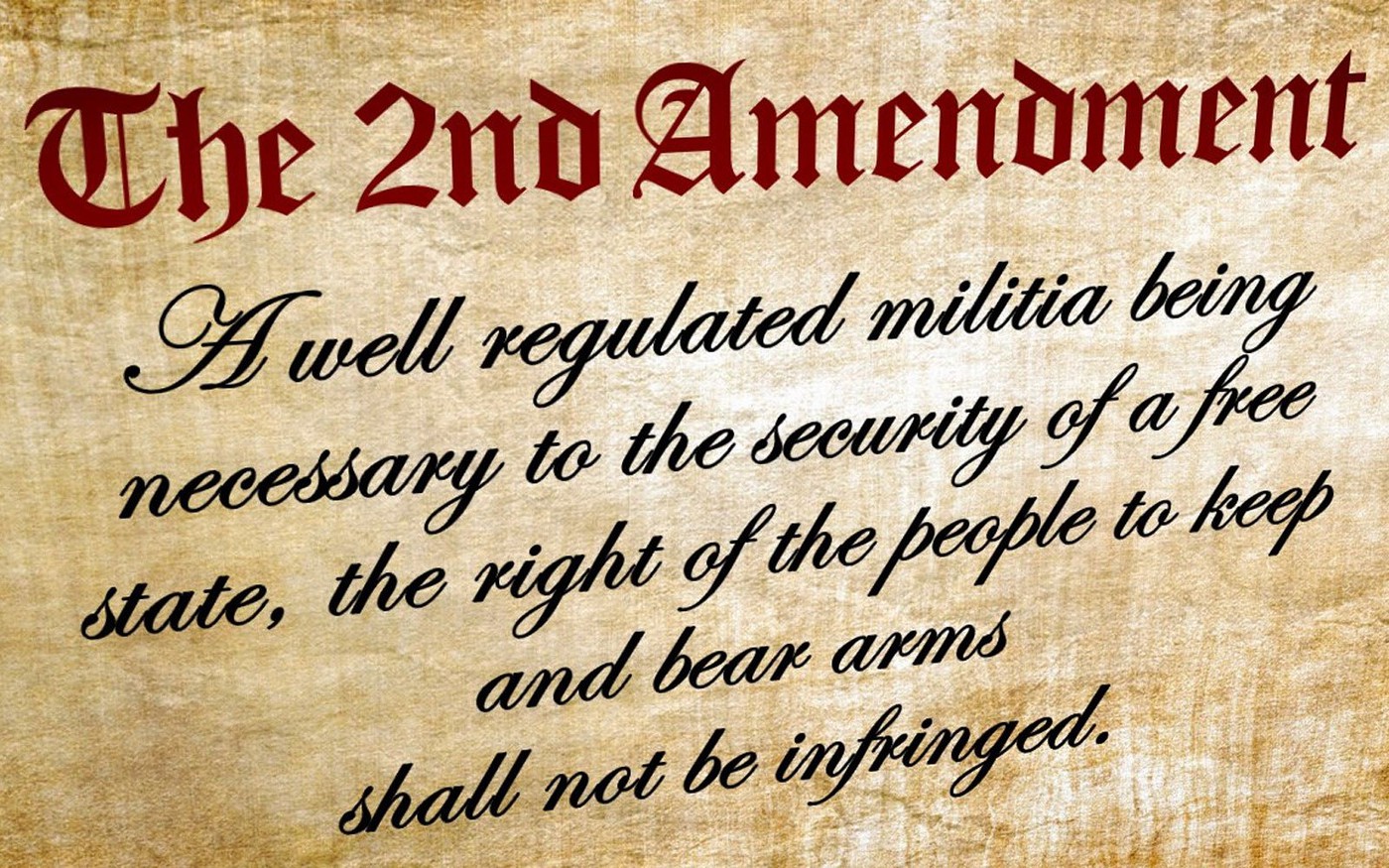
This Ping List is for all things pertaining to infringes upon or victories for the 2nd Amendment.
FReepmail me if you want to be added to or deleted from the list.
More 2nd Amendment related articles on FR's Bang List.
Disclaimer: Opinions posted on Free Republic are those of the individual posters and do not necessarily represent the opinion of Free Republic or its management. All materials posted herein are protected by copyright law and the exemption for fair use of copyrighted works.